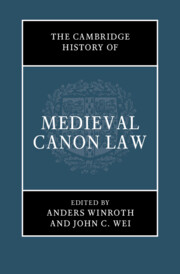Book contents
- The Cambridge History of Medieval Canon Law
- The Cambridge History of Medieval Canon Law
- Copyright page
- Contents
- Figures
- Maps
- Tables
- Contributors
- Acknowledgments
- Abbreviations
- Medieval Canon Law: Introduction
- Part I The History of Medieval Canon Law
- Part II The Sources and Dissemination of Medieval Canon Law
- Part III Doctrine and Society
- Iudicium
- Clerus
- Conubium
- 24 Marriage: Law and Practice
- 25 Family Law
- Crimen
- Conclusion
- Bibliography of Primary Sources
- Index
- References
25 - Family Law
from Conubium
Published online by Cambridge University Press: 13 January 2022
- The Cambridge History of Medieval Canon Law
- The Cambridge History of Medieval Canon Law
- Copyright page
- Contents
- Figures
- Maps
- Tables
- Contributors
- Acknowledgments
- Abbreviations
- Medieval Canon Law: Introduction
- Part I The History of Medieval Canon Law
- Part II The Sources and Dissemination of Medieval Canon Law
- Part III Doctrine and Society
- Iudicium
- Clerus
- Conubium
- 24 Marriage: Law and Practice
- 25 Family Law
- Crimen
- Conclusion
- Bibliography of Primary Sources
- Index
- References
Summary
A genuine canon law of the family developed in the high Middle Ages. It was built on papal decisions in specific cases during the second half of the twelfth century and the first decades of the thirteenth, and their interpretation by professors of law. Academic exposition was crucial in this legal field, more so than in others, since ecclesiastical legislation in the first millennium had taken little or no interest in the family. Church courts were largely forced to innovate, seeking papal verdicts and generating many papal rescripts that required interpretation by the masters. As was their wont, the ecclesiastical judges and the canonists also borrowed many rules from Roman law in order to fill the holes in canon law, which happened to touch only incidentally on certain questions, such as guardianship and adoption, and disregarded others entirely, such as emancipation.
- Type
- Chapter
- Information
- The Cambridge History of Medieval Canon Law , pp. 475 - 492Publisher: Cambridge University PressPrint publication year: 2022

